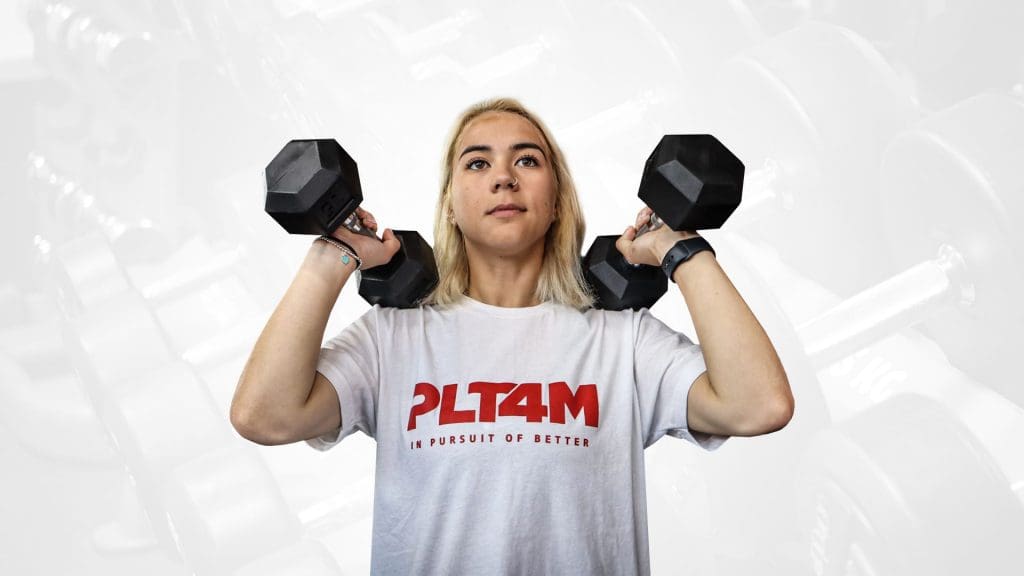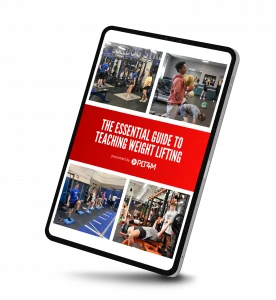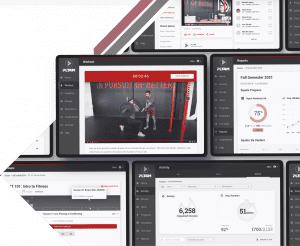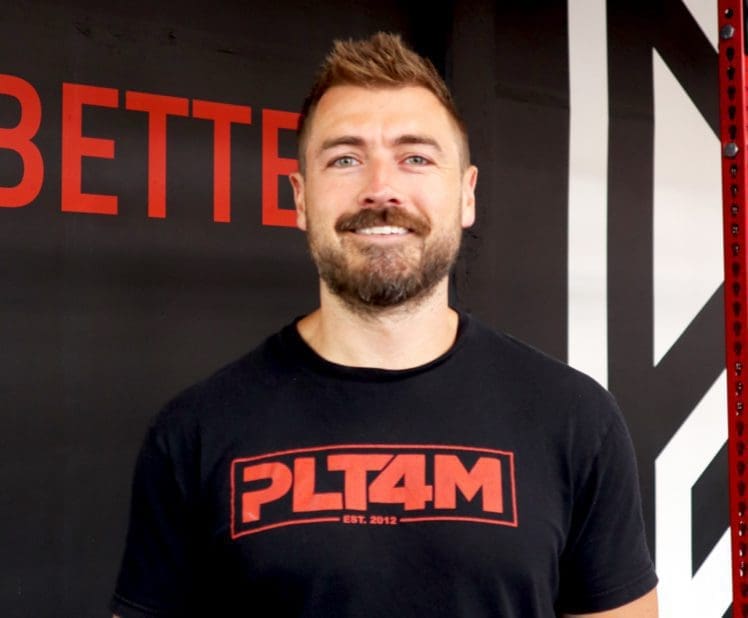
Meet The Author: Sam Breslin
- Co-founder,
- Director of Performance
- Certifications: CF-L1, CSCS*D.
Sam is embedded in every aspect of the fitness and performance training content here at PLT4M as our director of performance. That means he’s on top of everything from high-level program sketching to writing workouts and developing demo videos.
Until quite recently, high school strength and conditioning has been criminally undervalued and overlooked in educational institutions all across the country.
Strength and Conditioning, as a whole, has long been relegated to the private sector, collegiate level, or ‘highest level’ – disconnected from the mass education and development of our youth.
During the school day, many PE programs had moved away from formal fitness or strength education. For decades, far more attention was paid to the “academic” subjects. Our educational system had little emphasis placed on hard work, self-image, personal improvement, and physical/mental wellness.
Meanwhile, before and after school, sport coaches encouraged athletes to “lift” and train at something considerably beyond a developmental level. Parents and athletes were expecting greater and greater levels of athletic and sports performance. But, students lacked proper foundations or experience, while coaches and programs often lacked access to qualified instruction and programming.
In many places, the sum total of HS S&C were loosely run high school football strength and conditioning program that consisted of off-season football workouts each summer.
Now, though, we are all experiencing an exciting shift in focus. Physical and mental well-being has risen to the level of cultural priority, and a new educational pedagogy has appeared in the form of Long-Term Athletic Development.
Together, these evolutions have begun to bring Physical Education and Athletics together with a focus on proper education and development of ALL our student athletes, across the board.
These days, it’s hard to find someone who would argue against schools making a concerted effort to teach movement, fitness, and performance to all of their students in a progressional, appropriate manner.
Free E-Book: Essential Guide to Teaching Weight Training
Our newest E-Book outlines five essential steps for teachers or coaches aiming to initiate or improve their weight training program. Filled with extra resources, videos, and real-life examples, you’ll be delighted to have accessed this complimentary resource!
The Case For High School Strength and Conditioning Programs
With such a growing trend, it is no surprise that industry leaders are now outspokenly calling for the presence of qualified, certified, and experienced fitness professionals in EVERY high school.
It’s about time!
A few years ago, the NSCA itself published a white-paper on the benefits of hiring a full-time, credentialed and qualified strength coach at every high school. They made an obvious and clear case, citing benefits such as:
- Injury Prevention Amongst Athletes
- Proper Long-Term Athletic Development for ALL students
- Improved performance and long-term health
- Increased safety in the gym and on the field
Long story short – a well-run strength and conditioning program would benefit ALL.
Just as the Sciences, or the Arts, are a pillar of our educational system, so too should be physical wellness and athletic development.
In fact, one could argue that, of ALL the things our kids learn in school…how to live long, healthy, and happy lives through self care and self-improvement may be the most important.
We WHOLEHEARTEDLY agree.
In a perfect world, each of the over 15 Million current high school athletes and students across the country would have direct and consistent access to a certified fitness professional.
From the day they walk through the doors as a freshman, they would be subjected to a formal education of all things fitness and performance. From simple human movement standards to advanced athletic performance training – they would receive a consistent, appropriate, safe, and personalized experience day in and day out at the high school level.
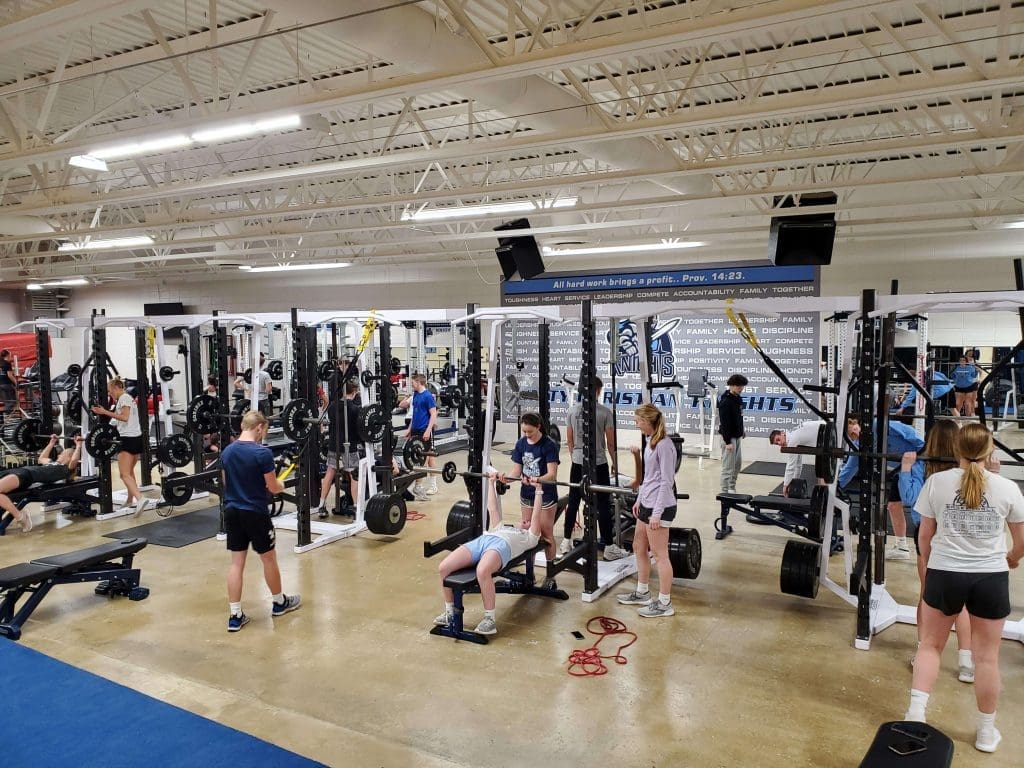
Can PLT4M Help At Your School?
Schedule a free 10 minute consultation to see how the PLT4M system can help save you time, and empower student learning!
The Reality – The Lack Of A High School Strength and Conditioning Coach
The unpleasant truth that we must face, though, is that such an ideal is not yet the world in which we live.
In the US alone, there are over 43,000 public and private “secondary” schools (those serving at least some of those 15 million students through grade 12) across the country.
At the same time, the NSCA claims just over 40,000 coaches – WORLDWIDE. (While not the only institution granting fitness certifications, it is arguably the gold standard, and the most popular for potential employers.)
We’re losing the numbers game, pure and simple.
Think of it this way:
Even if EVERY SINGLE CSCS Coach in the world worked with HS students → Each Coach would be responsible for almost 400 (!!) students per year.
In reality, there lies an even greater discrepancy. Most optimistic estimates put the actual number of high schools employing a full-time, certified strength coach at only 10-15%. This means that, at best, over 35,000 schools lack any qualified personnel to run their programs.
Currently, at the NCAA level, only 70% of DII/DIII athletic programs employ a certified strength coach, and as recently as 2004, even the D1 level only saw 70% of programs employing a NSCA certified coach.
It’s not hard to see, placing qualified professionals in every school will be an uphill battle for years to come.
The reality is that, in these schools, the responsibility of education and training falls to hard-working and well intentioned PE Teachers and Athletic Coaches. Most frequently, these individuals have no formal experience or background in the performance industry, nor, it is worth noting, do they claim to. They are often volunteering their time and energy for the benefit of their students and athletes.
So – what can we do??

The Current State of High School Strength and Conditioning Programs
The unfortunate juxtaposition of rising demand and such sparing supply has placed us all in an awkward, static spot.
Tell me if this sounds familiar:
- Coach posts video of a developmental athlete performing a “max clean” on Twitter
- Video demonstrates an alarming lack of attention paid to safety or technique
- Video goes viral
- Qualified strength professionals bash coach, athlete, and status of the space at large, piling on one after another.
Let’s be honest, we’ve all seen it – hell, we may have even participated.
But let me ask you this:
If there simply aren’t enough qualified coaches to properly teach and implement training with our youth athletes, what do we expect? Is our preferred alternative the complete inaction and missed education for 85% of our high school population?
The obvious answer is, “NO”, none of us want that – it flies in the face of the entire industry’s mission. Nor will thousands of athletes and teams just stop working out because they lack a professional to lead them.
In order to move forward, we need to find alternative solutions, ways in which we can create the greatest improvement for the greatest number – NOW, not just 10, 20 years from now.
Free E-Book: Essential Guide to Teaching Weight Training
Our newest E-Book outlines five essential steps for teachers or coaches aiming to initiate or improve their weight training program. Filled with extra resources, videos, and real-life examples, you’ll be delighted to have accessed this complimentary resource!
FOCUSING on the SOLUTION, not the PROBLEM
We have a culture that places increasing importance on true, developmental Strength and Conditioning at the high school level. At the same time, we have too few “professionals” to fill the national need. But, we do have an army of passionate teachers and coaches already working in the trenches, eager to help.
How can we most quickly, most efficiently, and most completely bridge this gap to the benefit of all?
The answer, it seems to us, is the fostering of open, collaborative dialogue and shared experienced amongst ALL those that find themselves in the role of “HS Strength Coach”, professional or otherwise.
It was this thought that inspired us, years ago, to start a project we called PLT4M (“platform”).
“The Rising Tide” Of Working Towards High School Strength And Conditioning
Partially shaped by an aphorism on economics made popular by John F Kennedy, our thought was that if community and collaboration could be fostered amongst ALL that found themselves in the role of HS S&C, we could elevate the entire industry, if only slightly, and slowly over time:
“A rising tide lifts all boats.”
If, on any given day, our efforts can lead to just ONE clean being caught in an improved front rack and power position, ONE squat avoiding complete valgus knee collapse on ascent, ONE pull from the floor maintaining a neutral spine, ONE HS implementing a full ground-up fitness curriculum…
Think of the cumulative effect!!
Thankfully, we found very quickly that we weren’t alone. There were already hundreds of like-minded individuals toiling away in an effort to achieve the exact same goal.
Organizations like the National High School Strength Coaches Association (NHSSCA) and the Society of Health and Physical Educators (SHAPE) had already turned their attention to the oft-neglected HS space in an effort to bring people together, to share ideas and resources – to EMPOWER those working with our students and athletes.
Our respect for these groups is almost too great to define. Hard-working teachers and coaches, themselves, they are continually striving to provide the entire industry with the support needed to raise the standard of HS strength training across the country.
To right away be amongst such esteemed company was humbling, to say the least.
Together we can turn the tide. With the sharing of collective wisdom and experience, we can, ALL of us, march toward the level of “professional.” We can raise one another up, turn the entire industry into a team of educators on a shared mission.
Let’s share the wealth. Educate one another, pass along experience, and remain open-minded. When ANY of us benefit – we ALL do.
Strength Training For High School Athletes – The Birth Of PLT4M
It was our sincere hope to add something tangible to this effort – a tool to facilitate the mission of High School coaches and educators across the country.
Inspired by our own use and enjoyment of HUDL while coaching, myself and my co-founder set out to create a software tool for HS Strength and Conditioning. We hoped to create a planning and management “platform” that could save coaches time and connect them to their athletes year-round, while also providing programs, videos, educational content and other resources to elevate the training happening at the HS level.
What started as a side-project for two former college teammates, current HS/College teachers and Football Coaches, has blossomed into a tool we hope will support all of those HS S&C coaches out there, no matter their personal backgrounds, with whatever they may need.
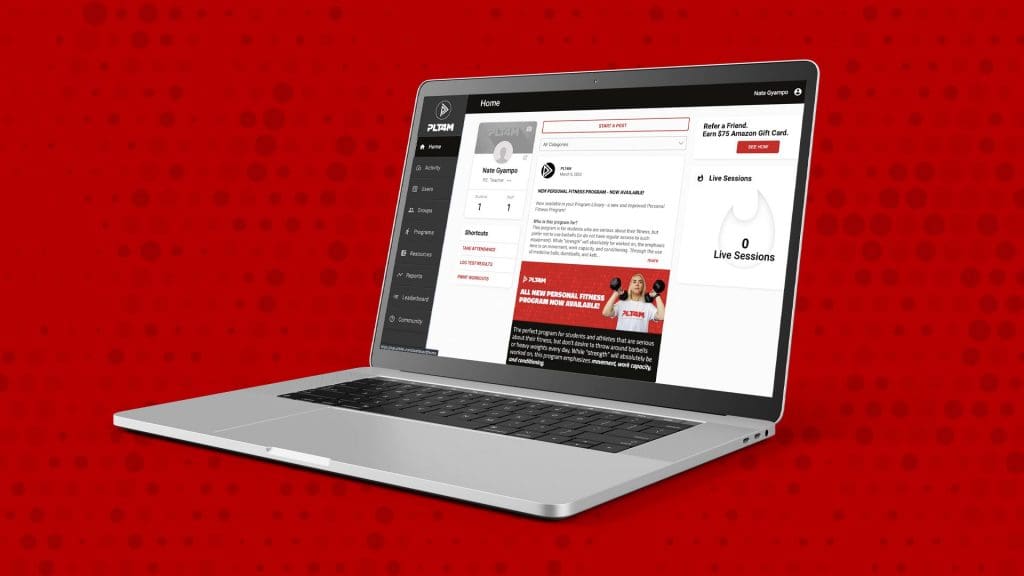
The Challenges of A High School Weight Lifting Program
Our initial goal was that of efficiency.
We, too, had spent countless hours in excel, had juggled multi-sport schedules, and drowned in paper workout sheets. We wanted to alleviate the administrative burden carried by the teachers and coaches running strength programs at their school.
At Dakota Valley High School in South Dakota, a school of just 350 students, Cody Sexton is tasked with coordinating the training of all 10 athletic teams throughout the year. Delivering personalized training while balancing overlapping sport schedules and experience levels was no easy task.
As did many of us, Cody first turned to Excel to execute his plans. It provided a structured method for delivering personalized workouts to each athlete, every week. As any experienced strength coach knows, though, Excel has its drawbacks.
“I had 100’s of tabs in excel and I would come in each weekend to print the updated workouts so kids had their personalized program.”
Fed up with slogging through max updates, copy and pasting, and individual printing for hours every weekend, Cody looked to PLT4M as a management tool.
PLT4M’s centralized system allowed him to house and update maxes with direct input from his athletes, populate workouts with precise and personal loading in real time, and deliver it all into the hands of his athletes without a single minute spent clicking through Excel tabs.
Even better, his administration threw in their support, purchasing iPads and iPad stands for the weight room. Using PLT4M’s Rack View, they could now load up to 5 athletes on each device. Athletes access their personalized workouts directly through the app and input their results in real time.
While Cody’s process of updating kids numbers each week hasn’t changed, it is now automated through PLT4M, streamlining the process and most importantly, giving Cody his weekends back.
Ready to Learn More?
Schedule a free 10 minute consultation to see how the PLT4M system can help save you time, and empower student learning!
More Than A High School Football Strength and Conditioning Program
While saving a single hard-working coach time and streamlining the daily training experience of athletes in the moment was a worthwhile endeavor – the idea of bringing everyone online had even loftier goals.
If we could help connect coaches and athletes in real time, year-round, we could help to foster a sense of unity amongst an ENTIRE athletic program.
Often many high schools have a football team or singular group that has a dedicated strength and conditioning program. But, a great high school athletic culture is one marked by a common vision – a shared purpose.
Nationally ranked athletic powerhouse, Loyola Academy in Illinois, exemplifies such a culture of success.
Jeff Lindeman, Head Strength Coach for all sports at Loyola Academy is a big part of that equation.
Coach Lindeman has served as the Strength & Conditioning Coordinator at LA for the last 11 years. During his tenure, he has fostered a culture of unity, hard work, and success that has resulted in dozens of state championships and a handful of national rankings across various sports.
This isn’t something that happened on it’s own, nor did it happen overnight.
Coach Lindeman wanted to use the S&C program at LA as a unifying factory, continually cultivating a school-wide sense of transparency and accountability. PLT4M provided him a way to connect everyone together.
PLT4M automatically logs every workout an athlete completes and tracks all the progress data that the coach wants. Coach Lindemann then gives access to all of the athletic coaches in school, allowing them to take a peek at their team anytime they want through their own App. They can see who’s logging workouts, what results are being entered, create group-specific progress/activity reports, or just review the day’s workout.
“My workouts weren’t changing, the technology was. We were getting kids more engaged through their favorite technology, bringing coaches into the process, and streamlining our administrative tasks.”
When you add all of this up, what do you get?
The athletes are more engaged than ever. They are taught great habits when they arrive, and accountability is reinforced year-round. Coaches have bought in and reaped the benefits.
Loyola Academy now has a training culture defined by commitment and progress. It’s this mindset, coupled with hard physical work that sets LA apart. They create better athletes, and better teams, year-round.
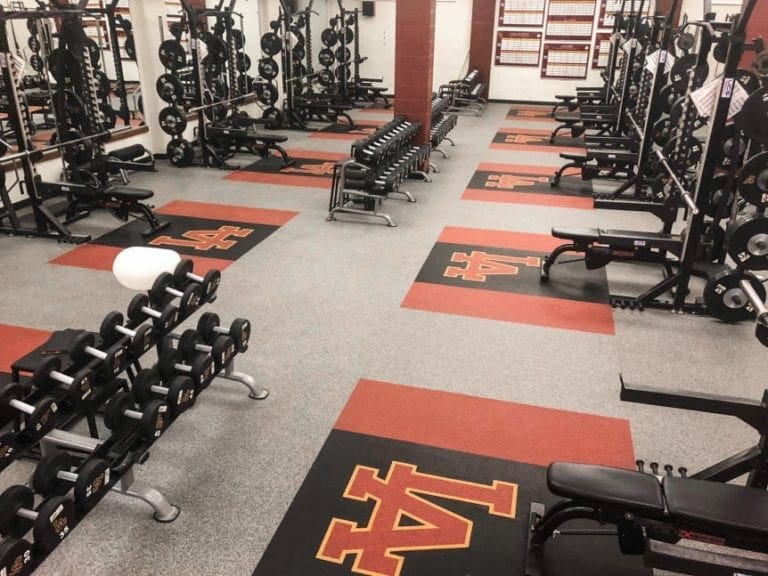
In-Class “Back Up”
While the “tech,” or software, was a powerful tool, and our first step, we wanted to take things even further. We wanted to share our own collective experience and expertise to every coach and athlete that may benefit.
To that end, we gathered a team of certified, experienced, and enthusiastic strength coaches and PE teachers to develop the educational resources needed to support such a large endeavor.
Together we created over a DOZEN pre-built and fully-fleshed out training programs for any user to use, or customize to their heart’s content. From introductory movement programs great for novice athletes, to full in-season and off-season training programs for competitive athletes. Coaches and teachers are free to use or modify as they see fit.
Additionally, we have built up a catalog of over 1,500 personally-produced educational videos that range from simple movement demonstrations to in-depth technique instruction.
The aim is never to replace the teacher and coach – but rather to be their “back-up” in the weight room.
In Glenwood HS (IL), for example, PLT4Ms extensive educational video library, coupled with personal delivery of class curriculums allowed experienced PE Teacher, Sara Hogan to avoid being stretched too thin in large classes of mixed-grade students.
Sara could first lead the class as a group, briefing and teaching the day’s main movements or lessons. Then, students could head out to work on their own, armed with a digital “textbook” per se, allowing them to take much greater ownership of their class time.
Fully developed lesson plans and easy to access educational videos for every element of the programs were both “essential in continuing education in class”. Sara, in fact, implemented a rule that highlighted this new accountability:
“Before coming back to ask a question of the teacher in the room, you must watch the relevant video and read its accompanying description in an effort to find the answer yourself.”
Instead of minimizing the teacher, the added resource of a personalized training app for each student actually highlighted the value of the teacher, and resulted in 2 phenomenal things…
- 1-on-1 Instruction: Teachers were less focused on administrative questions, like “what movement comes next?” or “what does this exercise mean again?” and free to focus on technique and individual instruction as needed once the class began.
- “Peer-to-peer” instruction: After the teacher led the class with the day’s main lessons, kids could review content at their own pace, and support one another as they learned and practiced.
In the end, it became an environment that every subject teacher wants – one in which their time is spent actually teaching, and working with kids that need extra instruction, rather than fielding administrative requests and review questions.
Long-Term Athletic Development
Above all, PLT4M’s mission is to help all High Schools implement a complete and coordinated approach to LTAD through their PE and Athletic Departments.
The ultimate goal is successfully getting every student athlete the complete education and training experience they deserve!
At St. Paul High School in Nebraska, a smaller school comprised of just a few hundred kids, Rusty Fuller serves as the Physical Education director for grades 7th through 12th, and is the Head Football Coach.
Rusty, and St Paul High, wanted to adopt such an approach to athletic development. The goal was to bring all students together, allowing them to work side-by-side, while still allowing for personalization and varying goals.
This was not without its challenges.
“Running a successful class training session with 30 kids of varying ability is hard. You’re trying to adapt things on the fly for different kids while also teach and instruct on proper form and mechanics.”
Rusty turned to PLT4M in hopes of streamlining this process from the ground up. He wanted something that offered instructional content to every student, programs for students and athletes alike, and allowed him to track a host of different data.
With PLT4M, he could combine his PE classes and athletic programs in a way he hadn’t been able to before.
As is the case with many small schools, a lot of the kids at St. Paul are multi-sport athletes. Rusty and his principal saw the value in PLT4M’s variety of programs. From holistic, multi-sport training, to education curriculums and personal fitness programs. This allowed Rusty to place different students on specific programs dictated by competitive seasons, as well as teach fitness to students not engaged in athletics.
St. Paul has thus established a comprehensive, yet flexible Physical Education curriculum that caters to each student’s individual needs. All 7th and 8th graders start with PLT4M’s Intro to Fitness and Intro to Training Programs, which establishes proper movement mechanics and a proper foundation. They then graduate to ‘Introduction to Weight Training’ – an in-depth, 3-Part educational program that acts as a great bridge into barbell and dumbbell resistance training.
From there they can move on to competitive athletic training or more advanced personal fitness regimens. Everyone is brought through a complete progression, personalized for them every step of the way.
Vision for the Future
PLT4M has come a long way over the past few years, and we very much look forward to whatever evolution the future holds.
We always consider ourselves a work in progress, influenced entirely by feedback from our users and our own experience as we continue to work with HS students and athletes in our lives outside of the office!
We sincerely hope we can offer ourselves, our resources, and our technology not as a simple “product”, but as an extension of our personal partnership with every coach and teacher that chooses to work with us.
The honest motivation behind PLT4M’s offerings is one of empowerment. We do not seek to replace, constrict, or hold any of our users to a strict prescription of process. Instead, we seek to offer our complete support to any who need it, in any way we possibly can. Follow our prescription to a T, or pick and choose what works best for you!
Our content is open source, making us a partner to all of our participating coaches, teachers, and student-athletes. We hope to create a collaborative online community of educators and athletes.
In the end, our hope is simple: to improve the lives of all of our members, to be a resource that coaches and teachers, of all kinds, can lean on in their daily fight in the world of HS S&C.
Ready to Learn More?
Schedule a free 10 minute consultation to see how the PLT4M system can help save you time, and empower student learning!
